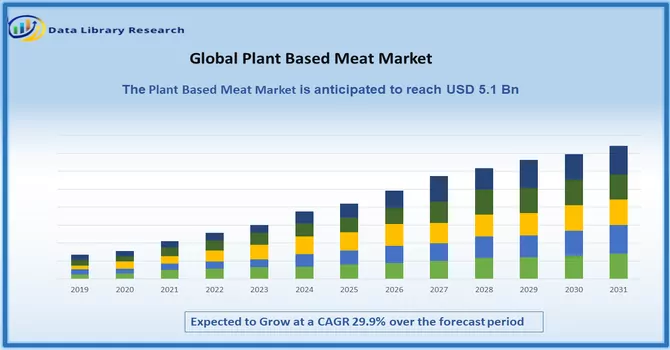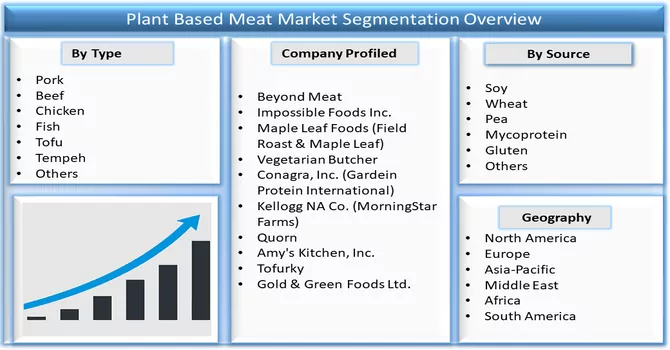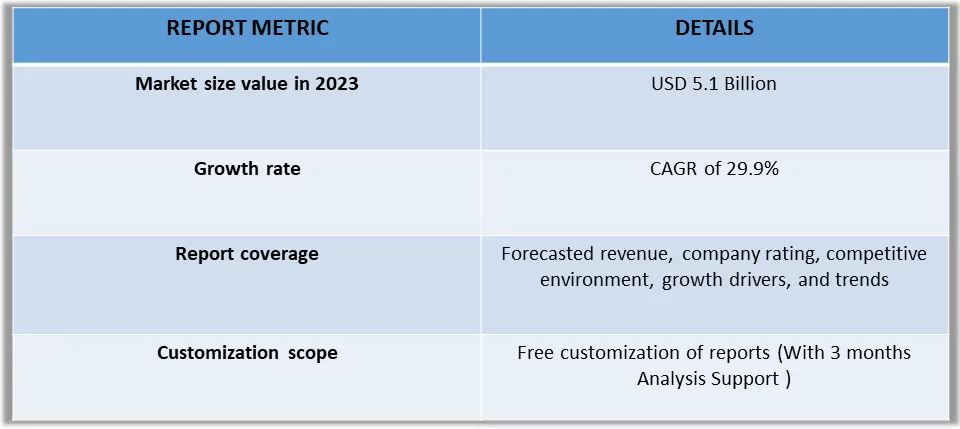The global plant-based meat market size was valued at USD 5.1 billion in 2023 and is expected to grow at a compound annual growth rate (CAGR) of 29.9% from 2024 to 2031.

Get Complete Analysis Of The Report- Download Free Sample PDF
The global plant-based meat market is experiencing a significant paradigm shift as consumers increasingly embrace plant-derived alternatives to traditional meat products. Driven by health-conscious choices, environmental sustainability concerns, and a surge in flexitarian and vegetarian lifestyles, the market has witnessed substantial growth. Plant-based meats, crafted from ingredients like soy, peas, wheat, and other plant sources, aim to replicate the taste, texture, and nutritional profile of animal-based meats.
The market is characterized by a diverse range of products, including burgers, sausages, nuggets, and ground meat substitutes. Key players in the industry are investing in research and development to enhance the taste and nutritional value of their offerings. The shift towards plant-based diets, supported by a growing awareness of the environmental impact of traditional meat production, positions the global plant-based meat market for sustained expansion in the foreseeable future. The global plant-based meat market is propelled by several key factors contributing to its robust growth. Firstly, a rising awareness of health and wellness has led consumers to seek alternatives to traditional meat products, aligning with dietary preferences that prioritize plant-based options. Additionally, the environmental impact of conventional meat production, such as greenhouse gas emissions and resource-intensive processes, has driven a surge in demand for sustainable and eco-friendly plant-based alternatives. The expanding consumer base adopting flexitarian and vegetarian lifestyles further amplifies market growth. Furthermore, continuous innovation and improvements in the taste, texture, and nutritional profiles of plant-based meats by industry players contribute to wider acceptance. The convergence of health consciousness, environmental sustainability, and innovation positions the global plant-based meat market as a frontrunner in the evolution of the food industry.
Market Segmentation: The Market is Segmented by Source (Soy, Wheat, Pea, Mycoprotein, Gluten, Others), Type (Pork, Beef, Chicken, Fish, Tofu, Tempeh, Quorn, Mushroom, Seitan, RTC/RTE, Natto, Others), and Geography (Asia-Pacific, North America, Europe, South America, and Middle East and Africa). The report offers market size and forecasts for pyrolysis oil in terms of revenue in USD million for all the above-mentioned segments.

For Detailed Market Segmentation - Download Free Sample PDF
The global plant-based meat market is experiencing dynamic trends that are reshaping the landscape of the food industry. One prominent trend is the surge in product diversification and innovation, with companies introducing a wide array of plant-based meat alternatives that mimic the taste, texture, and appearance of traditional meat products. Consumers are increasingly drawn to options such as plant-based burgers, sausages, and meatballs that offer a satisfying meat-like experience. Another notable trend is the growing availability of these products in mainstream retail outlets and restaurants, reflecting the rising acceptance and demand for plant-based alternatives.Moreover, there is a notable emphasis on clean labeling and natural ingredients, aligning with the broader clean eating movement. Transparency in labeling, highlighting the absence of artificial additives and genetically modified organisms, resonates well with health-conscious consumers. The global plant-based meat market is also witnessing strategic collaborations between food companies and renowned chefs to enhance culinary experiences and elevate the perception of plant-based options. As sustainability gains prominence, eco-friendly packaging and ethical sourcing of ingredients are becoming key considerations, shaping the market's direction towards a more environmentally conscious future. Overall, these trends underscore the evolving preferences and expectations of consumers in the plant-based meat sector.
Market Drivers:
Increasing Health and Environmental Consciousness
The growing awareness of health and environmental issues is a significant driver for the global plant-based meat market. Consumers are increasingly adopting plant-based diets due to concerns about health and wellness, including the desire to reduce cholesterol, lower saturated fat intake, and maintain a healthier lifestyle. Additionally, the environmental impact of traditional meat production, including deforestation, greenhouse gas emissions, and water consumption, has prompted consumers to seek sustainable and eco-friendly alternatives. As a result, the demand for plant-based meat products, which are perceived as healthier and more environmentally friendly, continues to rise.
Expanding Flexitarian and Vegan Consumer Base
The rise of flexitarianism and veganism is a key driver propelling the global plant-based meat market. Flexitarians, who primarily follow a vegetarian diet but occasionally consume meat, are seeking alternatives that provide the taste and texture of meat while aligning with their ethical and health-related choices. Plant-based meat products serve as a suitable compromise, allowing flexitarians to reduce their meat consumption without sacrificing the sensory experience. Additionally, the growing number of individuals adopting vegan lifestyles has fueled the demand for plant-based meat options that completely exclude animal-derived ingredients. As plant-based diets become more mainstream, the market is driven by the expanding consumer base embracing these dietary choices.
Market Restraints:
The global plant-based meat market faces certain challenges that may impact its growth trajectory. One significant restraint is the perceived taste and texture gap compared to traditional meat products. While advancements in technology and innovation have improved the sensory qualities of plant-based alternatives, some consumers still find them lacking the exact taste and texture of meat. Additionally, the higher cost of production and retail prices of plant-based meat products compared to conventional meat can be a hindrance, deterring price-sensitive consumers. Supply chain complexities, including sourcing and processing plant-based ingredients, also contribute to the higher overall costs. Moreover, regulatory frameworks and labeling standards vary globally, posing a challenge for companies in terms of consistency and compliance. Overcoming these barriers will be crucial for the continued success and broader acceptance of plant-based meat in the mainstream market.
The COVID-19 pandemic has exerted both positive and challenging influences on the global plant-based meat market. On one hand, the heightened focus on health and wellness during the pandemic has led to increased consumer interest in plant-based diets, promoting the adoption of plant-based meat alternatives. The perceived link between zoonotic diseases and traditional meat consumption has further accelerated this shift in consumer preferences. However, on the flip side, the pandemic has disrupted supply chains, affecting the availability and distribution of plant-based products. Production delays, logistical challenges, and changes in consumer purchasing behavior have all played a role. As the world navigates the ongoing pandemic and its aftermath, the plant-based meat industry continues to adapt, with the long-term impact being shaped by evolving consumer habits and the ability of companies to innovate and address supply chain resilience.
Segmental Analysis:
Soy Based Plant Protein Segment is Expected to Witness Significant Growth Over the Forecast Period
Soy-based plant meat is a popular and versatile alternative to traditional meat products, offering a sustainable and plant-based protein source for consumers. Made from soybeans, soy-based plant meat is rich in protein and provides a texture and taste similar to meat, making it a popular choice for vegetarians, vegans, and individuals looking to reduce their meat consumption. One of the key benefits of soy-based plant meat is its nutritional value. Soybeans are a complete protein source, containing all nine essential amino acids that the human body needs. Additionally, soy-based plant meat is low in saturated fat and cholesterol, making it a heart-healthy alternative to meat. Soy-based plant meat can be used in a variety of dishes, including burgers, sausages, meatballs, and stir-fries. Its versatility and ability to mimic the texture and flavor of meat make it a convenient and delicious option for those looking to incorporate more plant-based foods into their diet. In addition to its nutritional value and versatility, soy-based plant meat is also environmentally friendly. Producing soy-based plant meat requires significantly less land, water, and energy compared to traditional meat production, making it a more sustainable choice for environmentally conscious consumers. Thus, soy-based plant meat offers a nutritious, delicious, and sustainable alternative to traditional meat products, making it an excellent choice for individuals looking to adopt a more plant-based diet.
Chicken Segment is Expected to Witness Significant Growth Over the Forecast Period
Chicken is a popular source of protein in many diets, but for those looking to reduce their meat consumption or adopt a plant-based diet, there are several plant-based alternatives available. Plant proteins, such as those derived from peas, soy, and chickpeas, offer a nutritious and environmentally friendly alternative to chicken. Pea protein is one of the most common plant-based proteins used as a chicken alternative. It is rich in amino acids and has a texture similar to chicken, making it a popular choice for meat substitutes. Soy protein is another popular option, often used in products like tofu and tempeh, which can be used as chicken substitutes in various recipes. Chickpeas, or garbanzo beans, are also a great source of plant-based protein and can be used to create chicken-like dishes such as chickpea salad or chickpea cutlets. Chickpea flour can also be used as a binder in plant-based chicken products to help create a meat-like texture. Overall, plant proteins offer a versatile and sustainable alternative to chicken, providing a nutritious option for those looking to reduce their meat consumption or follow a plant-based diet.
North America Region is Expected to Witness Significant Growth Over the Forecast Period
In North America, the plant-based protein market is experiencing significant growth, driven by increasing consumer demand for sustainable and healthy food options. With a focus on environmental consciousness and health, consumers are seeking alternatives to animal-based proteins, leading to a surge in plant-based protein products. This trend is supported by a growing number of people adopting vegetarian, vegan, or flexitarian diets. Major food companies and startups are capitalizing on this trend by introducing innovative plant-based protein products, including burgers, sausages, and dairy alternatives, to meet the evolving preferences of consumers. As a result, the North American plant-based protein market is expected to continue its growth trajectory, presenting lucrative opportunities for businesses looking to invest in this rapidly expanding sector.

Get Complete Analysis Of The Report - Download Free Sample PDF
The analyzed market exhibits a high degree of fragmentation, primarily attributable to the presence of numerous players operating on both a global and regional scale. The competitive landscape is characterized by a diverse array of companies, each contributing to the overall market dynamics. This fragmentation arises from the existence of specialized solution providers, established industry players, and emerging entrants, all vying for market share. The diversity in market participants is underscored by the adoption of various strategies aimed at expanding the company's presence. On a global scale, companies within the studied market are strategically positioning themselves through aggressive expansion initiatives. This often involves entering new geographical regions, targeting untapped markets, and establishing a robust global footprint. The pursuit of global expansion is driven by the recognition of diverse market opportunities and the desire to capitalize on emerging trends and demands across different regions. Simultaneously, at the regional level, companies are tailoring their approaches to align with local market dynamics. Regional players are leveraging their understanding of specific market nuances, regulatory environments, and consumer preferences to gain a competitive edge. This regional focus allows companies to cater to the unique needs of local clientele, fostering stronger market penetration. To navigate the complexities of the fragmented market, companies are implementing a range of strategies. These strategies include investments in research and development to stay at the forefront of technological advancements, mergers and acquisitions to consolidate market share, strategic partnerships for synergies, and innovation to differentiate products and services. The adoption of such multifaceted strategies reflects the competitive nature of the market, with participants continually seeking avenues for growth and sustainability. In essence, the high fragmentation in the studied market not only signifies the diversity of players but also underscores the dynamism and competitiveness that drive ongoing strategic maneuvers. As companies explore various avenues for expansion, the market continues to evolve, presenting both challenges and opportunities for industry stakeholders.
Some prominent players in the global plant-based meat market include:
Recent Development:
1) In 2024, Burger King Germany's decision to reduce the price of all plant-based meals by 10 cents, making them cheaper than meat-based options, is expected to significantly impact the plant-based protein market. This move, part of the "Plant-based for Everyone" campaign, aims to encourage consumers to try meat-free options and highlight the variety of flavors available. The positive reception and increased demand for Burger King's plant-based range indicate a growing interest in plant-based foods. By making plant-based meals more affordable and accessible, Burger King is likely to attract new customers and potentially shift consumer preferences towards plant-based eating, driving further growth in the plant-based protein market.
2) In October 2022, Planterra, the plant-based meat division owned by JBS SA, made the decision to cease its operations in the United States. The company opted to shift its focus towards expanding into alternative protein markets, particularly in European countries and Brazil. This strategic move was driven by the slower-than-expected sales of plant-based meat products in the U.S. throughout 2022.
Q1. What was the Plant Based Meat Market size in 2023?
As per Data Library Research the global plant-based meat market size was valued at USD 5.1 billion in 2023.
Q2. At what CAGR is the Plant Based Meat market projected to grow within the forecast period?
Plant Based Meat Market is expected to grow at a compound annual growth rate (CAGR) of 29.9%.
Q3. What are the factors driving the Plant Based Meat market?
Key factors that are driving the growth include the Increasing Health and Environmental Consciousness and Expanding Flexitarian and Vegan Consumer Base.
Q4. Which region has the largest share of the Plant Based Meat market? What are the largest region's market size and growth rate?
North America has the largest share of the market. For detailed insights on the largest region's market size and growth rate request a sample here.
Data Library Research are conducted by industry experts who offer insight on industry structure, market segmentations technology assessment and competitive landscape (CL), and penetration, as well as on emerging trends. Their analysis is based on primary interviews (~ 80%) and secondary research (~ 20%) as well as years of professional expertise in their respective industries. Adding to this, by analysing historical trends and current market positions, our analysts predict where the market will be headed for the next five years. Furthermore, the varying trends of segment & categories geographically presented are also studied and the estimated based on the primary & secondary research.
In this particular report from the supply side Data Library Research has conducted primary surveys (interviews) with the key level executives (VP, CEO’s, Marketing Director, Business Development Manager and SOFT) of the companies that active & prominent as well as the midsized organization
FIGURE 1: DLR RESEARH PROCESS

Extensive primary research was conducted to gain a deeper insight of the market and industry performance. The analysis is based on both primary and secondary research as well as years of professional expertise in the respective industries.
In addition to analysing current and historical trends, our analysts predict where the market is headed over the next five years.
It varies by segment for these categories geographically presented in the list of market tables. Speaking about this particular report we have conducted primary surveys (interviews) with the key level executives (VP, CEO’s, Marketing Director, Business Development Manager and many more) of the major players active in the market.
Secondary ResearchSecondary research was mainly used to collect and identify information useful for the extensive, technical, market-oriented, and Friend’s study of the Global Extra Neutral Alcohol. It was also used to obtain key information about major players, market classification and segmentation according to the industry trends, geographical markets, and developments related to the market and technology perspectives. For this study, analysts have gathered information from various credible sources, such as annual reports, sec filings, journals, white papers, SOFT presentations, and company web sites.
Market Size EstimationBoth, top-down and bottom-up approaches were used to estimate and validate the size of the Global market and to estimate the size of various other dependent submarkets in the overall Extra Neutral Alcohol. The key players in the market were identified through secondary research and their market contributions in the respective geographies were determined through primary and secondary research.
Forecast Model
